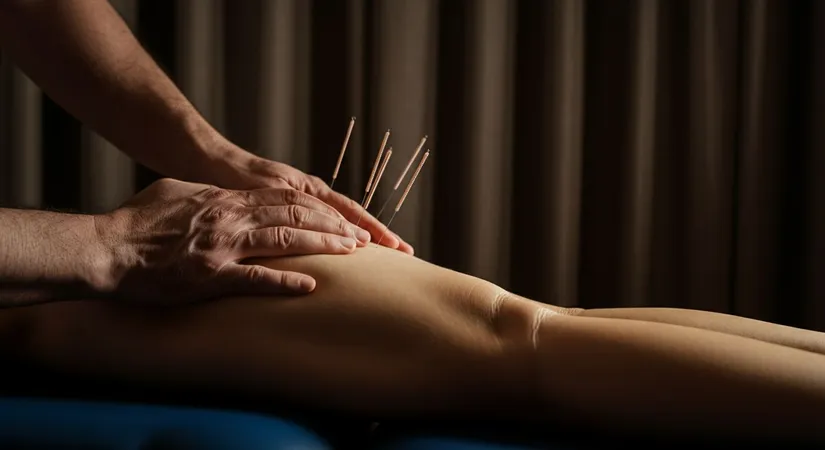Unlocking the Secrets of Acupuncture Points: A Path to Holistic Healing
Discover the holistic healing powers of acupuncture points to enhance your well-being.
With its roots in traditional Chinese medicine, acupuncture is an ancient practice that plays a crucial role in holistic healing. Known for its ability to enhance the body's natural ability to balance and heal itself, acupuncture focuses on stimulating specific points on the body called acupuncture points. These points are believed to trigger various biochemical and physiological reactions that benefit the body's overall wellness. This article explores the nuances of these points and how they contribute to effective acupuncture therapy for physical and emotional health.
Understanding What Acupuncture Points Are
The Role of Acupuncture Points in Traditional Chinese Medicine
Acupuncture points, or acupoints, are integral to traditional Chinese medicine, serving as focal points for energy flow. These points are believed to channel "qi" through meridians, influencing overall health. The concept of qi is central to understanding how acupuncture therapy works.
For instance, the Lung Meridian, associated with respiratory health, includes acupoints that practitioners target to alleviate breathing issues. Similarly, the Stomach Meridian's points are used to address digestive concerns. These examples highlight the specificity and targeted nature of acupuncture therapy.
Key Characteristics of Acupuncture Points
- Acupuncture points are strategically located along meridians, each linked to specific organs or functions.
- They are used to diagnose and treat various ailments by restoring balance in the body's energy flow.
- Acupoints are often stimulated using needles, but other methods like acupressure or moxibustion can also be effective.
How Acupuncture Points Facilitate Healing
- Identification of Blockages: Practitioners assess qi flow to identify blockages or imbalances.
- Targeted Needle Insertion: Thin needles are inserted into specific acupoints to stimulate energy flow.
- Restoration of Balance: The stimulation helps restore balance, promoting natural healing and alleviating symptoms.
Understanding acupuncture points is crucial for appreciating the benefits of acupuncture therapy. By targeting these points, practitioners aim to enhance holistic healing and improve overall well-being.

Exploring the Benefits of Acupuncture Therapy
Enhancing Health Through Acupuncture Therapy
Acupuncture therapy is renowned for its ability to improve various aspects of health. By targeting specific acupuncture points, this therapy can significantly reduce pain and stress levels. For example, studies have shown that acupuncture can decrease chronic back pain by up to 50% in some patients.
Moreover, acupuncture therapy is often used to boost the immune system. By stimulating acupoints, it encourages the production of white blood cells, enhancing the body's ability to fight infections. This makes it a valuable complementary treatment during flu season.
Key Benefits of Acupuncture Therapy
- Non-invasive and minimal side effects, making it suitable for various patients.
- Can be combined with other treatments for improved health outcomes.
- Promotes holistic healing by addressing both physical and emotional well-being.
Steps to Achieve Optimal Results with Acupuncture
- Initial Consultation: Discuss health concerns and goals with a certified practitioner.
- Customized Treatment Plan: Develop a plan targeting specific acupuncture points for desired outcomes.
- Regular Sessions: Attend sessions consistently to maintain and enhance therapeutic benefits.
Acupuncture therapy offers a holistic approach to health, addressing both physical and emotional aspects. Its versatility and minimal side effects make it an appealing option for those seeking alternative or complementary therapies.

How Acupuncture Points Aid in Pain Relief
Mechanisms of Pain Relief Through Acupuncture
Acupuncture points are strategically targeted to alleviate pain by stimulating the body's natural healing processes. This involves the release of endorphins, which are the body's natural painkillers, and the reduction of inflammation, contributing to pain relief.
For example, targeting the LI4 point, located on the hand, can help relieve headaches and facial pain. Similarly, the ST36 point on the leg is often used to alleviate knee pain and improve digestion. These examples illustrate how specific points are chosen based on the type of pain experienced.
Key Benefits of Acupuncture for Pain Management
- Non-pharmaceutical approach, reducing reliance on medications.
- Can be tailored to individual pain profiles, enhancing effectiveness.
- Promotes overall well-being by addressing underlying causes of pain.
Steps to Effective Pain Relief with Acupuncture
- Assessment: Identify specific pain areas and related acupuncture points.
- Targeted Treatment: Apply acupuncture to selected points to stimulate healing.
- Follow-up: Monitor progress and adjust treatment for sustained relief.
Acupuncture therapy offers a holistic and personalized approach to pain management, making it a valuable alternative for those seeking relief without the side effects of conventional medications.
The Role of Traditional Chinese Medicine in Acupuncture
Integrating Traditional Chinese Medicine with Modern Practices
Traditional Chinese Medicine (TCM) forms the philosophical backbone of acupuncture, emphasizing a holistic approach to health. This integration focuses on balancing the body's energy, known as "qi," through acupuncture points, which are strategically located along meridians.
For instance, TCM practitioners often combine acupuncture with herbal remedies to enhance therapeutic effects. A patient experiencing digestive issues might receive acupuncture targeting the Stomach Meridian, complemented by herbs that support digestion. This dual approach exemplifies how TCM addresses health concerns comprehensively.
Key Elements of Traditional Chinese Medicine in Acupuncture
- Holistic healing: TCM considers the body, mind, and environment as interconnected.
- Personalized treatment: Each patient receives a tailored approach based on their unique health profile.
- Complementary practices: Acupuncture is often paired with tai chi or dietary adjustments for enhanced outcomes.
Steps to Integrate TCM with Modern Medical Techniques
- Assessment: Evaluate the patient's condition using both TCM and modern diagnostic tools.
- Combination Therapy: Develop a treatment plan that includes acupuncture and other TCM modalities.
- Monitoring and Adjustment: Continuously assess the patient's progress and adjust treatments as needed.
The integration of Traditional Chinese Medicine with modern medical practices offers a comprehensive approach to health, enhancing the effectiveness of acupuncture therapy. This synergy not only addresses symptoms but also targets the root causes of health issues, promoting overall well-being.
Acupuncture Points: The Foundation of Holistic Healing
Acupuncture for Pain Relief: A Natural Approach
Frequently Asked Questions
What are acupuncture points and how do they work?
What are the benefits of acupuncture therapy?
How does acupuncture aid in pain relief?
How is traditional Chinese medicine integrated into acupuncture therapy?
What should I expect during an acupuncture session?
Discover the path to 'Healthy Beauty' with estethica's expert care. Call now for your free consultation and take the first step towards a more confident you!
📞 Call for Your Free Consultation